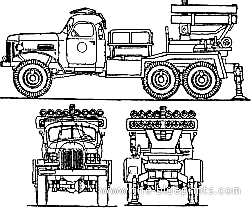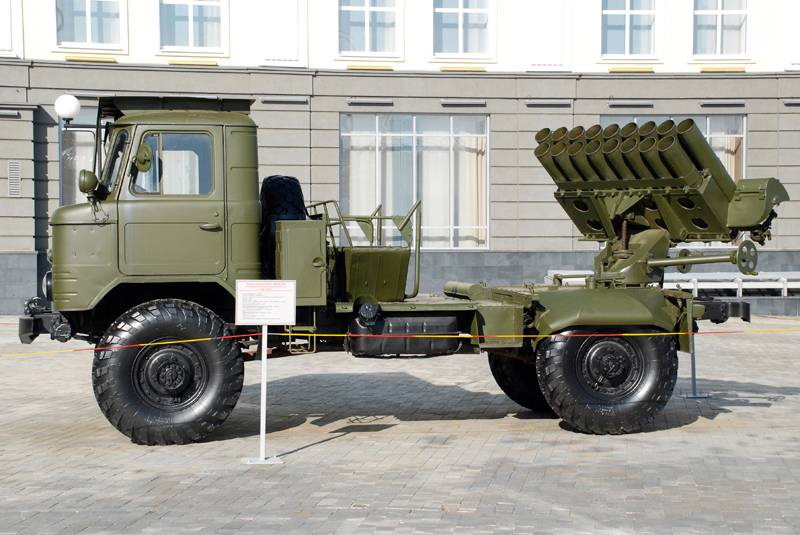BM-14
 Soviet Union
Soviet Union
Truck (1952) - c5000 built
Upgrading the Katyusha
The experience of Katyushas in WW2 such as the iconic
BM-13 a weapons system adapted on many truck platform, became one of the favorite alternatives to traditional artillery used by the Soviet Union. They were far easier, simpler to use, cheaper, less labour-intensive and requiring small crews compared to traditional artillery, which needed time to deploy and could only land ordnance so much in a short time. The rocket launcher, also used by the Germans almost from the start of WW2 was found a quick and powerful solution to saturate any point of the front. By 1945, the Soviet Union had more rocket launching vehicles than any other country. It stayed potent enough to be kept in the cold war inventory for decades. Only the systems became more accurate and the rocket, longer range and more deadly, and of course, new truck platforms were introduced.
The BM-14 is an older Soviet multiple rocket launcher system that preceded the BM-21 Grad. It was developed in the late 1940s and early 1950s and saw extensive use in various conflicts during the Cold War era. It was a Multiple Rocket Launcher System (MRLS) firing sixteen 140 mm rockets or 17 (see variants) which could reach a range of 9.8 km to 10.8 km, depending on the rocket variant and was typically mounted on a ZIL-157 or ZIL-131 6x6 truck, providing off-road mobility or the nimbler 4x4
GAZ 63. All rockets could be launched in about 7–10 seconds. The vehicle had a 5-person crew. The BM-14 was designed for area bombardment, firing a salvo of unguided rockets at enemy targets. It was especially effective against concentrations of infantry, artillery positions, and lightly armored vehicles, though its range and firepower were less advanced compared to later systems.
Detailed Design

The BM-14 (BM for Boyevaya Mashina or 'combat vehicle') was designed from the start by NII 303 bureau as a 140mm multiple launch rocket system (MLRS) which mount had the advantage of having both traverse and elevation, making it more useful than the simple fixed ramps of earlier vehicles. The core of the system were the 140 mm M-14 rockets dispensing a high-explosive fragmentation warhead on target, or a smoke warhead, or a chemical warhead on demnad. It was designed to replace the BM-13 "Katyusha" until replace itself late by the BM-21 Grad. The base launcher was developed in a 16 and 17-round variants, lackiong accuracy but very effective in saturation fire.
The truck itself varied greatly between variants, in order, the ZIS-151 (6x6), ZIL-157 (6x6), GAZ-63A (4x4) and finally the GAZ-66 (4x4). Given the small size of the launcher it made more sense on a lighter 4x4 truck, freeing larger models for other uses. In all cases, the flatbed received fixations for the launcher to be fixed atop the rear twin or single axle depending on the case, with tailored mudguards place above. The launcher was manually operated and pointed on target by one member of the crew, with handle wheels for elavation and traverse. The truck itsef was unarmoured, except in sime version armoured windows were procured for the size and front windows and unarmed for close defence except for a machine gun on the roof if the model was provided with a hatch for the co-driver. The two other crew members helped reloading the vehicle after firing if needed.
M14 Rocket
 The towed launcher RPU-14
The towed launcher RPU-14
The main reason for the vehicle to exist was its BM-14 launcher equipped with the same mass-produced 140mm rockets of the M-14-series, also called "M14 artillery rockets", with a minimum range of 3.8 kilometers (2.4 mi) and maximum range of 9.8 kilometers (6.1 mi). Three models were available:
- M-14-OF: high-explosive fragmentation (HE-Frag) warhead 3.68 kilograms (8.1 lb) TNT.
- M-14-D: Smoke warhead (white phosphorus).
- M-14-S: Chemical warhead (2.2 kilograms/4.9 lb sarin).
The 140 mm (5.5 in) rockets were 1 m (3 ft 3 in) long and weighted each 39.6 kg (87 lb). Muzzle velocity was 400 m/s (1,300 ft/s) at a max range of 9.8 km (6.1 mi)
The launcher could elevate at +50° and traverse 180° on either side.
Variants
The vehicle as it existed in its basic form was called the BM-14 GRAU designator 8U32 as carrying the initial launcher with two rows of 8 and mounted on the 1952 ZIS-151 6x6 truck. It was later retrospectively called the BM-14-16. The next BM-14M GRAU 2B2 was improved with the same launcher but mounted on the more modern 1958 ZIL-157, produced from there. The next BM-14MM, GRAU 2B2R, was the final upgrade of the 17-tube launcher this time mounted on the 1960s ZIL-131. Production stopped and concentrated on the 17 barrle versions, seems more promising.
The BM-14-17 (8U35) managed to place 17-round in a 8 top, 9 bottom tubes on a more compact and light launcher, which could be mounted on the much smaller 4x4 GAZ-63A. It was eveloped in 1959 and allowed to free the larger ZIL-151/157 for their transport role. This small launcher was also convenient fior other used and notably was adopted by the Navy for ground support on riverine vessels and the used Project 1204 patrol boats. The next iteration of the 17-tubes variant was the BM-14-17M, GRAU 8U35M which swapped the GAZ-63A for the even lighter and more recent GAZ-66 4x4 truck. This was the last variant, largely exported and used until 1990 despite the success of the BM-21 Grad. There was also a twoed variant called the RPU-14, GRAU designation 8U38 which was the 16-round version on a reconverted 85 mm D-44 gun carriage, only deployed by Soviet Airborne Troops, until replaced by the modern BM-21V "Grad-V".
BM-14-16: (8U32)Initial 16-round model with two rows on the ZIS-151 (1952), also BM-14-16.
BM-14-17: (8U35) Variant with 17 rocket tubes on the GAZ-63A.
BM-14-17M: (8U35M) Variant on the GAZ-66.
BM-14M: (2B2) Modernized version with better fire control on the ZIL-157.
BM-14MM: (2B2R) final upgrade on the ZIL-131.
RPU-14: (8U38) towed version.
Operators
 Algeria: 48 BM-14/16
Algeria: 48 BM-14/16 Angola, BM-14-16s during the Angolan Civil War, possibly ex-Cuban.
Angola, BM-14-16s during the Angolan Civil War, possibly ex-Cuban. Cambodia: 20 BM-14-16
Cambodia: 20 BM-14-16 Republic of Congo ? unknown
Republic of Congo ? unknown Cuba: Same
Cuba: Same Egypt: 32
Egypt: 32 Indonesia Indonesian Marine Corps (Korps Marinir) operated 36 BM-14-17 launchers
Indonesia Indonesian Marine Corps (Korps Marinir) operated 36 BM-14-17 launchers North Korea: Type 63 130mm on GAZ-63 copy
North Korea: Type 63 130mm on GAZ-63 copy Poland: Unknown numbers, replaced BM-21s 1970s
Poland: Unknown numbers, replaced BM-21s 1970s Russia: Only BM-14-17 mounted on Shmel-class Project 1204 PBs
Russia: Only BM-14-17 mounted on Shmel-class Project 1204 PBs Somalia − BM-14-16 and BM-14-17
Somalia − BM-14-16 and BM-14-17 South Yemen: 15 BM-14 in 1989.
South Yemen: 15 BM-14 in 1989. Syria: 200 BM-14 purchased in 1967, retired 2016.
Syria: 200 BM-14 purchased in 1967, retired 2016. Vietnam: Purchased or donated from 1967.
Vietnam: Purchased or donated from 1967.
| BM-14-17 (GAZ-63A) |
| Dimensions: | 5.4 x 1.9 x 2.24 m (17 ft 9 in x 6 ft 3 in x 7 ft 4 in) |
| Weight: | 5,323 kg (11,735 lb) |
| Tires: | 4x4 chassis |
| Crew: | 6 |
| Propulsion: | GAZ-51 6-cyl. petrol 70 HP |
| Speed: | 65 km/h (40 mph) |
| Range: | 650 km (400 mi) |
| Payload: | 17x 140 mm 39.6 kg L14 rockets |
| Production: | |
Service

The BM-14 was used by the Soviet Union and its allies during the Cold War and was exported to numerous countries. It saw action in conflicts in Africa, the Middle East, and Asia. However, by the late 1960s and 1970s, it was largely replaced by the BM-21 Grad in Soviet and other Warsaw Pact arsenals due to the latter’s superior range, firepower, and mobility. Despite being an older system, some countries continued to use the BM-14 due to its low cost and ease of operation, particularly in irregular or insurgent forces.
In 2013 such systems were spotted in August in use during the Syrian Civil War, with M-14 rocket engines identified and collected by the U.N. fact-finding mission in the Muadamiyat al-Sham district, Damascus, of the chemical type. (Attack on Western Ghouta, 21 August).
Sources
soviet-mlrs-1950-1960
militaryfactory.com
weaponsystems.net
militaryperiscope.com
weaponsystems.net
wiki BM-14